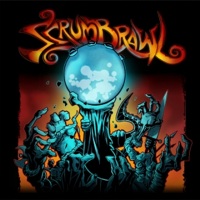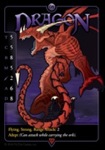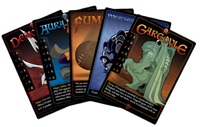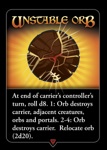
|
About OgreCave and its staff
|

|
by Dennis Hancock
ScrumbrawlPublished by VicTim Games LLCGame Design by Victor Moyer & Tim Bugher Contents: Board, 58 Small Creature/Orb Cards, 100 Standard Deck Size Creature/Enhancement Cards, 4 Rules Reference Cards, 12 Plastic Stands (3 of each, Red, Blue, Black, White), Four D20 (Two Red, Two Blue – although the rules claim I should only have one of each), Two D8, Three Portal Tokens, Eight Orb Tokens, Ten Red Point Counters, Ten Blue Point Counters, and a single 36 page rulebook. Price: $39.95 If you like the idea of Bloodbowl but don't especially feel like painting miniatures, or feel the rules may be a bit too cumbersome, Scrumbrawl might be just the game you are looking for. It combines the feel of football or rugby, wizardry, and fantasy scale gladiatorial combat. Throw in an orb that could blow up at any given moment, rendering the carrier into a puddle of goo, and you have a game the whole family can enjoy... ok, maybe not the whole family, pretty darn close though.
Presentation
The game tokens are your standard run of the mill pre-punched card stock. The portal tokens, as well as the orb tokens, have a larger diameter than the point tokens. My concern is that the point tokens are pretty small and could be easily lost. I suppose this isn't too much of a problem, as most gamers have some sort of glass beads or dice lying around which could be used as a suitable substitute. The dice and plastic stands are what I would describe as industry standard.
Gameplay I just about choked when I saw the rulebook. For a game that takes about 30 minutes to complete with two players, the small rulebook tallied up 36 pages. I was relieved when I found much of that was nothing more than stats for each creature and explanations on special rules for some of the cards. In total, the game rules are explained in twelve pages, thirteen if you count the rules for optional game modes. These special modes include team games and "last man standing". Before any players draw cards or determine who goes first, the orb(s) must be randomly selected from the eight available (some of which have different attributes). The orb and portal locations are then randomly determined by rolling a red and blue twenty sided die and locating their corresponding numbers on the game board, then intersecting the associating columns and rows. This must done for each orb and portal to be in play. For a two player game, the Scrumbrawl designers suggest one portal and one orb. For a three player or more game, they suggest two portals and two orbs. Players then roll a D20 to determine who goes first. Player one then draws four cards from the play deck – if there are no creature cards, the player may reveal their hand, discard the cards, and draw four new cards. If an instant event is drawn during the first turn, it is discarded and a new card is drawn to replace it. On the first turn only, each player may continue to repeat these steps until at least one creature card is pulled. Order of play is as follows: (displayed on Rules Reference Cards)
Event Cards come in two flavors: Played Events and Instant Events. Played events are used at the time and choosing of the player who holds the associated card, during any phase of any players turn. Instant Events are played as soon as they are drawn, with the exception of each player's first turn. Instant events have a series of instructions that are to be followed, and once the outcome is determined, they are to be discarded and a new card drawn. If the new card is an Instant Event, follow the instructions, discard, and draw. Repeat until no new Instant Events are drawn. Enchantment cards also come in two varieties: some are to be played on a creature, others are to be played on a whole team. Enchantments will state they are for a creature or are a team bonus. Without enchantments, creatures are only able to take a single wound before they die. Enchantments act as armor of a sort, absorbing a second wound. An enchanted creature getting wounded doesn't die – instead, they lose their enchantment and can fight on. The effects of an enchantment will be stated on the associated card. Alter Reality cards come in denominations of 2, 3, and 5, and may be used to alter just about any die roll. The user of the card may alter a die up to the number displayed on the Alter Reality card. Alter Reality cards cannot be used to affect orb scatter placement if it would mean placing an orb/portal/creature outside of the arena, or to alter instant effects or creature ability rolls to a result of less than one or greater than eight. Each creature card has several stats: Throw, Catch, Range, Movement, # of Attacks, Attack Rating, and Defense Rating. The throw and catch ratings come into play when one creature decides to throw an orb to another. The throwers 'throw' score is added to the catchers 'catch' score, then the player rolls a D20. If the result is less than or equal to the sum of both creature's scores, the throw was successful. If the throw is failed, a D8 is rolled to determine the scatter location of the orb. Should the orb land in the square of another creature, that creature picks up the orb. The Range score determines how far a creature can throw an orb. Once a creature throws an orb or takes a swing at another, their movement is done, so it's important to use all movement points before throwing or attacking. Using movement and then throwing an orb is a good way to cover long distances, assuming you can make that catch. Once a receiver has caught an orb, they are free to use their movement and then throw again if they desire. Adjacent creatures may hand off an orb if they desire to do so. There may be instances in which a player does not want to catch an orb, for instance, if that orb is the 'Killer Orb'. The rules for this orb state a carrier of this orb is destroyed at the end of the controlling players turn. If your creature just can't seem to make it to a portal on your turn, you may be better off throwing it at an enemy. In this case, the thrower makes an attack using their throw score versus the intended target's defense score. At this point, the spiky orb of death hurtles through the air, presumably at the target's head. If the shot connects, the target takes damage, possibly killing it in the process.
Ranged and Melee attacks are similar to one another. The attacker's ranged or melee attack score is compared to the defender's defense score. Both players then roll a D20 and add their respective scores to the number rolled on the die, and alter reality cards are then taken into consideration along with any enchantments in play. The highest score wins the combat, with ties going to the defender. If the attacker has multiple attacks, they then proceed with whichever are remaining. In the case of a failed Melee attack, the defender has the option to counterattack and possibly kill the assailant. A roll of 1 is always a miss, and 20 is always a hit. The only way to defend against an attack roll of 20 is to also roll a 20 for defense. It may seem like a rare event, but during testing my opponent managed to do this on three separate occasions during a single game (beginners luck?). The winner of a combat may collect the loser's creature card, called a skin. Three skins may be redeemed for one red point. After a player scores a goal, the portal disappears and a new location is determined by rolling the red and blue D20s. A new orb is also randomly drawn and then placed on the field in the same manner as the portal.
Conclusions Ratings
Ease of Play: 4 of 5 Stars. The rules may seem complicated at first glance, but they really aren't.
Links:
|
||

 What the field lacks, the playing cards more than make up for. Each
glossy playing card has a nicely illustrated picture to go with the
Creature, Enchantment, or Instant Effect displayed. They also contain a
brief description of each creature, enchantment, or effect and any
special rules pertaining to those cards. As a nice side benefit, the
rulebook contains a complete listing of all special abilities and
creatures in the game. The durability of each playing card is typical
for what I would expect from any other board game, not quite as durable
as a package of Vegas style playing cards, but suitable enough for your
average gamer... just try not to use them as drink coasters. The
mini creature and orb cards are considerably thicker than the playing
cards, and rightly so. These get taken in and out of the included
plastic stands repeatedly as each creature is summoned or killed. The
illustrations on the mini cards match those of their corresponding
playing cards, glossy finish and all.
What the field lacks, the playing cards more than make up for. Each
glossy playing card has a nicely illustrated picture to go with the
Creature, Enchantment, or Instant Effect displayed. They also contain a
brief description of each creature, enchantment, or effect and any
special rules pertaining to those cards. As a nice side benefit, the
rulebook contains a complete listing of all special abilities and
creatures in the game. The durability of each playing card is typical
for what I would expect from any other board game, not quite as durable
as a package of Vegas style playing cards, but suitable enough for your
average gamer... just try not to use them as drink coasters. The
mini creature and orb cards are considerably thicker than the playing
cards, and rightly so. These get taken in and out of the included
plastic stands repeatedly as each creature is summoned or killed. The
illustrations on the mini cards match those of their corresponding
playing cards, glossy finish and all. Creature cards are just what you expect: a creature may be summoned
during your turn on steps two or four of the order of play. You may only
have three creatures under your control on the battlefield at any time.
During the first turn they are summoned, they can't move, maneuver the
orb, or initiate combat. If a creature is summoned into the same square
as an existing creature, the existing creature is destroyed... sort of
like telefragging. If the creature is summoned into the same square as a
portal, the creature is destroyed. If a creature is summoned into the
same square as an orb, it becomes an orb carrier – this includes being
summoned into the same square as an orb carrier, in which case the new
arrival would splatter the original carrier, then pick up the orb. As
stated earlier, freshly summoned creatures may not initiate combat, but
they may counterattack.
Creature cards are just what you expect: a creature may be summoned
during your turn on steps two or four of the order of play. You may only
have three creatures under your control on the battlefield at any time.
During the first turn they are summoned, they can't move, maneuver the
orb, or initiate combat. If a creature is summoned into the same square
as an existing creature, the existing creature is destroyed... sort of
like telefragging. If the creature is summoned into the same square as a
portal, the creature is destroyed. If a creature is summoned into the
same square as an orb, it becomes an orb carrier – this includes being
summoned into the same square as an orb carrier, in which case the new
arrival would splatter the original carrier, then pick up the orb. As
stated earlier, freshly summoned creatures may not initiate combat, but
they may counterattack.
 Along with the 'Killer Orb' there are seven others that should keep
things entertaining. For the 'Unstable Orb', the controlling character
makes a D8 roll at the end of their turn. On a roll of 1, the 'Unstable
Orb' explodes, killing the carrier and taking out everything adjacent to
it, portals and all; on a 2-4 it merely destroys the carrier; and on a
result of 5-8, the carrier can breathe a sigh of relief and fight for
another round. The 'Slippery Orb' requires the player to roll a D8 any
time a creature attempts to pick up, throw, or hand off, resulting in a
50% chance the ball gets fumbled. The 'Chaos Orb' relocates the carrier
at the beginning of its turn, during pick up, catch, or hand off. The
'Shield Orb' allows the carrier to take a +4 point bonus to their
defense. The 'Heavy Orb' eliminates the flying characteristic while
carried, and cannot be carried by weak creatures. It also penalizes -1
Movement and -3 Range to normal creatures, while strong creatures are
completely unaffected. The 'Crystal Orb' shatters on a fumble, failed
catch, or a drop by a destroyed creature, while the 'Leather Orb' has no
special rules at all.
Along with the 'Killer Orb' there are seven others that should keep
things entertaining. For the 'Unstable Orb', the controlling character
makes a D8 roll at the end of their turn. On a roll of 1, the 'Unstable
Orb' explodes, killing the carrier and taking out everything adjacent to
it, portals and all; on a 2-4 it merely destroys the carrier; and on a
result of 5-8, the carrier can breathe a sigh of relief and fight for
another round. The 'Slippery Orb' requires the player to roll a D8 any
time a creature attempts to pick up, throw, or hand off, resulting in a
50% chance the ball gets fumbled. The 'Chaos Orb' relocates the carrier
at the beginning of its turn, during pick up, catch, or hand off. The
'Shield Orb' allows the carrier to take a +4 point bonus to their
defense. The 'Heavy Orb' eliminates the flying characteristic while
carried, and cannot be carried by weak creatures. It also penalizes -1
Movement and -3 Range to normal creatures, while strong creatures are
completely unaffected. The 'Crystal Orb' shatters on a fumble, failed
catch, or a drop by a destroyed creature, while the 'Leather Orb' has no
special rules at all.